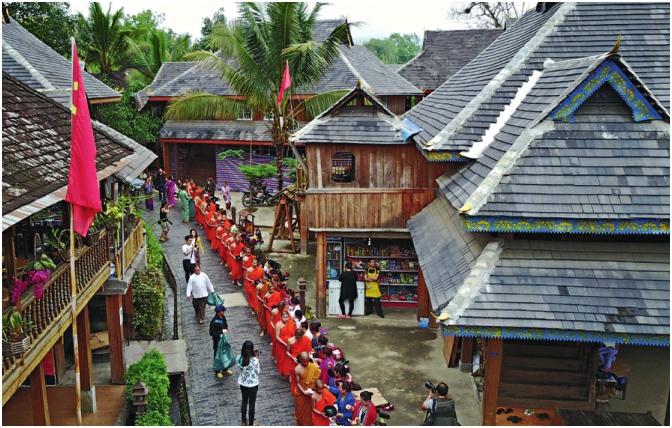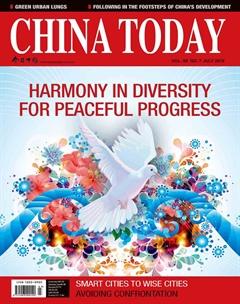Bamboo Houses of the Dai People
By GUO ZHIDONG
People of the Dai ethnic group in Xishuangbanna, Yunnan Province, traditionally live in housing constructed of bamboo stalks. Such buildings have the merits of being damp-proof, well ventilated, protected against wild animals and insects, and resistant to floods. With distinctive architectural features, they represent a key type of traditional Chinese dwellings.
THE Dai ethnic minority mostly live in Xi- shuangbanna and other regions in Yunnan Province. Their architecture, including temples, bridges, and residences, have unmistakably local features, with the bamboo home, a type of stilt house, being the most iconic.
The tropical climate in Xishuangbanna bestows an abundance of bamboo growth in the region, which makes for a ready supply of building materials for the Dai people. Locals structure their homes with bamboo and thatch them with locally grown hay. They do not cost much, and the quality is high.
Large bamboo stalks are chosen for the skeleton of the house, and bamboo strips are lined to make the wall. Twenty to 24 quadrangular columns are erected to shore up the building. The quadrangular shape can keep away snakes, as its edges can scratch their scales. Beams perch on the columns, and are lavishly carved in some houses. A bamboo-strip floor about two meters above the ground divides the inner space into two stories.
Flooding is frequent in the rainy season in Xishuangbanna. The stilted structure and porous walls of bamboo strips save the building from the onslaught of flooding, keep it well ventilated, dampproof, and out of reach of wild animals and insects.
The bamboo houses of the Dai people are largely square-shaped. The first floor is for storage and farm animals, and the second floor, cooler and drier, is the living space for the owners family. Over the past years,many Dai people have renovated their homes with timber and replaced thatched roofs with wood panels or tiles. The new design is more secure.
The lower and upper spaces of the bamboo houses are linked by stairs. On the second floor, the compartment next to the stairs is the sitting room, where the family gathers together or receives guests. A large bamboo mat in the center is where they sit. And a fire pit with the upper ridges at about 15 cm above the floor serves as the cooking stove, heater, and source of light. Behind the sitting room is the bedroom. In front of it are the colonnade and balcony. The former is the space where the residents do some chores, have meals, and take breaks. Visitors can also be brought there. The latter is the place where the residents do the washing and drying, and place water tanks.
The Dai people are hospitable. They invite visitors to touch the central column of their houses, which is inscribed with Buddhist texts handwritten by a master monk. Its believed that the act of touching can give the visitor blessings. Being the most sacred part of the house, this column is said to protect the building from disasters. People are prohibited from leaning on or placing things around it. Some families wrap it with red silk, and many put leaves beneath it during the construction with the belief that the practice will make it more enduring.
Visitors are not allowed to enter, or even peep into the bedroom because the guardian of the family“resides” in a column in this room. This column is wrapped in white cloth, and surrounded by banana leaves, sugar cane seedlings, candles, and cotton strips. After an elder member of the family passes away, the body is placed against the column for other members to do the cleaning. The Dai people believe in Buddhism and espouse animism. They believe outsiders seeing the column of their guardian will bring misfortune to the family, and therefore keep visitors away from their bedroom.
There are many rules to be observed in the construction of Dai homes. For instance, a residence cannot be located in front of or next to a Buddhist temple, and it cannot be taller than the podium of the Buddhist statue in the shrine.
When one Dai family starts to build a new home, the entire neighborhood joins to help. On its completion, all the neighbors gather for a joyous celebratory ceremony, and folk artists perform songs of congratulations, which are believed to bring peace and prosperity to the occupants.
In feudal times there were rigorous specifications for the residences of officials and ordinary people. Those of average families were banned from the use of tiles and carving ornaments. Whats more, the colonnades of their houses could not be of three sections, the sitting room could not have six-panel lattice doors, the stairs could not be of two flights, and the columns could not stand on stone bases, etc.
Seniority is also factored in the design of Dai homes. The residences of the elder generation are taller and free of herringbone-structured beams inside, and their stairways are longer (more than nine steps, compared with seven or less in houses for younger generations).
The Dai people often circle their homes with bamboo fences and various tropical plants, such as coconut, grapefruit, banana, pawpaw trees, and bamboos. These sleek buildings enliven the serene, lush landscape of the frontier region of Xishuangbanna.
Xishuangbanna Dai Ethnic Park
Located in the southern suburb of Jinghong City, Xishuangbannan Dai Autonomous Prefecture, the park consists of five well-preserved Dai villages dotted with traditional Myanmar-styled pagodas and Dai bamboo houses in each of them. The Manchunman Temple is the oldest Buddhist shrine in the prefecture, dating back 1,400 years. At the square at the gate of the park, Dai people greet visitors with welcome dances and songs, and sprinkle water on them to express best wishes. At the Water Splashing Square, visitors can have some experience of the most ceremonial and joyous festival of the ethnic group.
Transport: Take a shuttle from Minzu North Road in Jinghong City to the park. The drive takes one hour.
- CHINA TODAY的其它文章
- People-oriented Development Brings Boons to Both China and the World
- Xi Urges Joint Efforts to Open Up New Prospects for Asian Security,Development
- Commercialization of 5G Accelerates Digital Transformation
- Romania Holds 1st TCM International Conference
- Global Communication Shall Not Be Subject to U.S.‘Digital Hegemony’
- Huawei’s World View

